Intergovernmental Panel on Climate Change (IPCC)

The Intergovernmental Panel on Climate Change (IPCC) assessment is of critical importance to the future of all humanity, because it is the sole source of science recognized and relied on by governments in climate change decision making and international climate discussions.
Over the years the IPCC assessments have confirmed the theoretical climate change effects of health- almost all adverse.
The first image below is from the 2007 IPCC 4th assessment, the graphic below from IPCC 1995 and the chart of vector diseases the 2001 assessment.
The IPCC panel is unique in being comprised of experts and inexpert policy makers representing the world nations. The IPCC does not advise on dangerous climate change, nor make recommendations.
This cries out for medical organizations to do so, and for an environmental risk assessment which would do both.

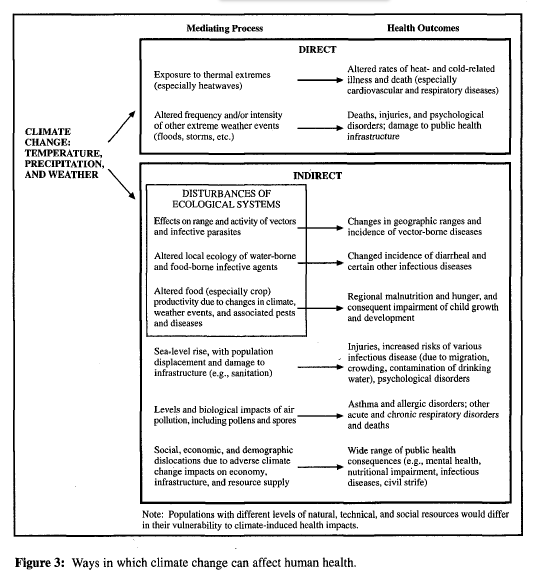

The adverse impacts on populations, below from the 2007 IPCC assessment (WG2 SPM), clearly showed the situation to be extremely dangerous for billions of the most climate change vulnerable - a warming of 1.5C already being locked. Under 1.5C is the position of a majority of nations inthe UN climatye negotiations. The chart showed that the 2C policy target is intolerably devastating to the most vulnerable billions and the danger limit is 1.0C (as J.Hansen et al 2013 Dangerous climate)
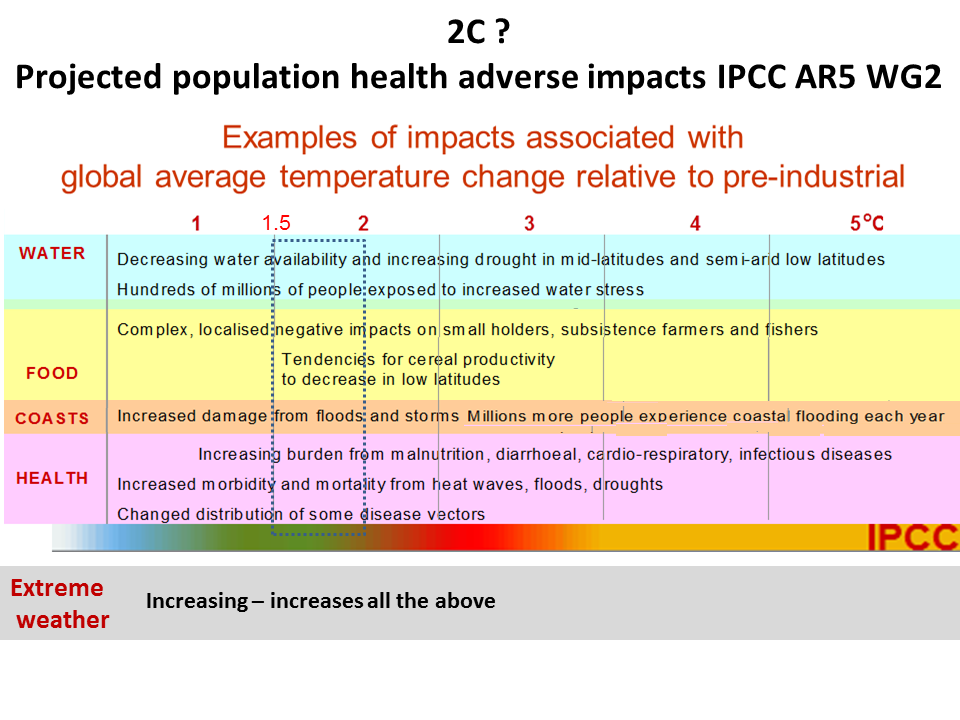
IPCC 2014 AR5 The most obvious health impacts are from increased heat, which will impact populations in the low latitudes most severely. The map from IPCC AR5 below shows the majority of the world's population lives in regions subject to risk of heat exhaustion, so even slight global warming will put all these regions at high risk. The populations in regions at high risk today will suffer terribly under more warming.

The IPCC 2014 AR5 uses a chart called 'Reasons for concern' to show the risk of increasingly severe impacts as warming increases. It is not a risk assessment in terms of risk being the product of probability times magnitude of an impact. It shows the same situation with respect 1.0C being the danger limit,

The fifth IPCC assessment report (AR5) was released September 2013 through 2014.
Only the short Working Group 1 to 3 Summaries for Policy Makers (SPM) are recognized as the science basis by governments and international climate negotiations. There is a final short Synthesis Report for the benefit of policy makers.
The IPCC AR5 has a chapter on health.
From the AR5 Health chapter Executive Summary below
'In recent decades, climate change has contributed to levels of ill health
Pojected health effects include:
- Greater risk of injury, disease, and death due to more intense heat waves and fires
- Increased risk of undernutrition resulting from diminished food production in poor regions
- Consequences for health of lost work capacity and reduced labor productivity in vulnerable populations
- Increased risks of food- and water-borne diseases and
- vector-borne diseases
The most effective measures to reduce vulnerability in the near term are programs that implement and improve basic public health measures such as provision of clean water and sanitation, secure essential health care including vaccination and child health services, increase capacity for disaster preparedness and response, and alleviate poverty.'
Malaria '..the association between hot days and increases in mortality is very robust...climate change at least quadrupled the risk of extreme summer heat events in Europe in the decade 1999–2008. The 2003 heat wave was one such record event..' (11.4)
Dengue is the most rapidly spreading mosquito-borne viral disease, showing a 30-fold increase in global incidence over the past 50 years. Each year there occur about 390 million dengue infections worldwide (11.5.1.2)
Other vector borne diseases can be expected to increase with global warming and climate change.
'The strongly nonlinear response to temperature means that even modest warming may drive large increases in transmission of malaria, if conditions are otherwise suitable' (11.5.1.1.)
Hemorrhagic fever with renal syndrome (HFRS) is a zoonosis caused by the Hanta virus The incidence of this disease has been associated with temperature, precipitation, and relative humidity
Plague, persists in many parts of the world. Outbreaks have been linked to seasonal and interannual variability in climate
Chikungunya fever is a climate-sensitive mosquito transmitted viral disease first identified in Africa, now present also in Asia, and the disease has recently emerged in parts of Europe
The incidence in China of Japanese encephalitis, another mosquito-borne viral disease, is correlated with temperature and rainfall, especially during the warmer months of the year.
In West Africa, outbreaks of Rift Valley Fever, an acute viral disease affecting humans and domestic animals, are linked to within-season variability in rainfall.'
Cholera Risk of infection is influenced by temperature, precipitation, and accompanying changes in salinity due to freshwater run of. In countries with endemic cholera, there appears to be a robust relationship between temperature and the disease. In addition, heavy rainfall promotes the transmission of pathogens when there is not secure disposal of fecal waste. An unequivocal positive relationship between Vibrio numbers and sea surface temperature in the North Sea has been established by DNA analyses..(11.5.2.1.)
Rates of diarrhea have been associated with high temperatures. Rainfall has also been associated with enteric infections.
11.5.3. Air Quality
It is projected by WGI that climate change could affect future air quality, including levels of photochemical oxidants and,with much less certainty, fine particles (PM2.5).
Nearly all the non-CO2 climate-altering pollutants are health damaging, either directly or by contributing to secondary pollutants in the atmosphere
Higher temperatures may magnify the effects of air pollutants like ozone...
Tropospheric ozone is formed through photochemical reactions that involve nitrogen oxides (NOx), carbon monoxide (CO), methane (CH4), and volatile organic compounds (VOCs) in the presence of sunlight and elevated temperatures. Therefore, if temperatures rise, many air pollution models project increased ozone production especially within and surrounding urban areas.
Wildfires, which occur more commonly following heat waves and drought, release particulate matter and other toxic substances that may affect large numbers of people for days to months
11.6.1. Nutrition In summary, we conclude that climate change will have a substantial negative impact on (1) per capita calorie availability; (2) childhood undernutrition, particularly stunting; and (3) on undernutrition-related child deaths
The most important new science in AR5 is that temperate region crops will decline above 1.0 with the sole exception of temperate rice that declines at 2C, which is much earlier than projected in previous assessments. Even then the models still do not capture many large adverse effects. Also most disconcerting the AR5 finds that now climate change is causing more crop yield negative effects than possible positive effects increases.
Extreme weather events as we know are increasing, and will keep doing so with more warming.
A great many impacts are being felt on all continents and in all oceans.
The 2007 4th assessment report (AR4) stated that-
Climate change contributes to the global burden of disease and premature deaths (very high confidence). At this early stage the effects are small but are projected to progressively increase in all countries and regions. (Ch 8 Exec summary & 8.4.1.)
Projected impacts on population health start at under 1C (i.e. now) and include.
- increases in malnutrition and consequent disorders, with implications for child growth and development;
- increased deaths, disease and injury due to heatwaves, floods, storms, fires and droughts;
- the increased burden of diarrhoeal disease;
- the increased frequency of cardio-respiratory diseases due to higher concentrations of ground-level ozone related to climate change; and,
- the altered spatial distribution of some infectious disease vectors.
(WG2 SPM C. Health)
The worst affected regions are in Africa.
For Africa 'by 2020, between 75 million and 250 million people are projected to be exposed to increased water stress due to climate change. Agricultural production, including access to food, in many African countries and regions is projected to be severely compromised by climate variability and change'.
Here is the short IPCC AR4 2007 section from the Summary for Policy Makers on health. The SPM can only be published when it has been reviewed and revised to the approval of Panel policy makers.
This is the long comprehensive IPCC AR4 2007 technical report on human health. This is approved by all the Panel scientists and not scrutinized by the policy makers.
Research not included in the last IPCC assessment is not recognized by governments and unavoidably as a result, policy making is always some years out of date on the science.
This is a big problem for the AR5 because the climate denial campaign are claiming warming has stopped because the global temperature increase has stalled since 1998 (see WMO graph bottom page). Global warming is sustained- not stopped, and the NH sumer increase has not stalled and the Arctic rate of temperature increase continues to soar now over 3 X the global average.
As was widely recognized at the time, the 2007 4th IPCC assessment (AR4) showed that the situation was beyond dangerous climate interference and risks global climate catastrophe. Severe impacts to water, food and health affecting billions of people was projected at under 2C and some under 1C. (see image bottom page).
This was conveyed by the IPCC Chairman Dr R. Pachauri at Copenhagen. "It is a great privilege for me to address this august gathering at the beginning of a historically important meeting, which we all hope would lead to action – action which is required urgently on the basis of the scientific assessment of climate change presented in the Fourth Assessment Report (AR4) of the IPCC. [...] This conference must also lead to urgent initiation of large scale mitigation actions." R Pachauri Chairman IPCC Opening Copenhagen Climate Conference 7 Dec 2009.
We can't expect the actual IPCC assessment to warn that we in a state of planetary emergency as James James Hansen did in 2008 and again 2012. We cannot actually expect the assessment to warn we are past dangerous interference with the climate system, as John Holdren started presenting in 2006.
That is not how the IPCC assessments work.
Basically, the IPCC collects and collates all the published climate change research over the past many years. It presents it in an orderly manner and as three sequential sections - the science, the impacts, and the solutions. The IPCC terms of reference from governments means it is left it to others (policy makers and other leading institutions of society) to draw conclusions and make recommendations for government and international policy.
IPCC achievements
The IPCC first assessment was in 1990. The IPCC has done us all a tremendous service by dealing with the global warming denial campaign. Though it took over 20 years the IPCC has proved beyond doubt that global warming is real and has real damaging impacts, and that it caused by our fossil fuel energy industrial civilization.
After the 2007 fourth IPCC assessment (AR4) it was widely acknowledged that actions had to be taken most urgently to avert planetary catastrophe.
The IPCC Chair R Pachauri made his famous statement "If there's no action before 2012, that's too late. What we do in the next two to three years will determine our future. This is the defining moment."
The Chair of the IPCC science report Susan Solomon said if emissions were not cut the planet could warm by 6.4C.
All three IPCC Working Group chairs in presenting their reports said action had to be taken "now".
The fact that the assessments are approved by all world governments, as well as all the world scientists, on the Panel before they can be published, is a powerful answer to the denial campaigners.
AR5 no change in IPCC 'conservatism'
It is now general knowledge that the IPCC assessments are highly conservative- to the point of underestimating impacts. The reason, I believe, is largely due to the constant pressure from the unscrupulous climate denial campaign. How ever environmental health protection policy making in general has tended to be far from precautionary, taking decades of public pressure to get a dangerous environmental toxic pollutant regulated.
Having acted as an expert IPCC assessment reviewer, I can say there are no great differences to drive political will in the AR5 compared with the AR4, which was the last assessment in 2007.
The AR5 excludes all carbon feedbacks including the large Arctic amplifying feedbacks from its so-called 'most likely' future global temperature increase projections, even though UNEP has pointed out the huge error that results from excluding Arctic feedbacks (Policy Implications of Warming Pemafrost 2012).
Scenarios
The AR5 is based on new (RCP) scenarios (taking a different approach) that as published are still all fossil fuel energy dependent (to 2100), even though the RCPs are said to now include climate change policy (unlike the previous SRES scenarios). The Special Report on Emissions Scenarios (SRES) are still useful as they confirm we are tracking the worst case high emissions scenario A1FI. The best and worst case scenarios for SRES and RCP are similar, except the upper range of warming by 2100 for SRES (A1FI) in much higher and more likely as it includes a consideration of carbon feedbacks. The best case RCP (2.6) is below 1.5C by 2100 and declining. The scenarios graphic (bottom page) shows the best and worst case for the IPCC SRES and RCP scenarios.
Zero carbon
The global temperature and ocean acidification cannot stabilize without all industrial carbon emissions stopping (zero carbon policy).
'Only in the case of essentially complete elimination of emissions can the atmospheric concentration of CO2 ultimately be stabilised at a constant level. All other cases of moderate CO2 emission reductions show increasing concentrations because of the characteristic exchange processes associated with the cycling of carbon in the climate system.' IPCC AR4 FAQ 10.3 para 6
But there is not an RCP scenario for renewal energy dominance by 2100. Carbon emissions and atmospheric reduction is based on the assumed success of extracting CO2 from the air, not by converting all fossil fuel energy to clean zero carbon energy.
The best RCP mitigation scenario projection correctly reaches zero carbon followed by negative carbon. However it still takes over 50 years to get to zero emissions in its best case, on the assumption that emissions will only be reduced slowly, and that there will be no emergency rapid response.
The best case in RCP scenario correctly reaches 350 ppm CO2, but it relies on wishful thinking after 2050 by removing CO2 from the air.
Economics
The policy making final decision on an assessment is always made based on the cost benefit economics.
Like the AR4 the AR5 applies the standard environmentally perverse economics that drives continuous maximum economic expansion, and is the root cause of atmospheric GHG pollution.
Options for mitigation are all according to costs and not benefits, as is the case if fossil fuel energy is fully costed and economic benefits of renewable energy fully included. The 2006 Stern Commission, which found costs of not mitigating compared to mitigation are overwhelmingly great, is not mentioned in the AR5 (it was in AR4).
The result is a strong impression that mitigating global climate change will hurt national and world economies. That only applies if economic costs and benefits remain fossil fuel biased leading to what Stern called the greatest and most most market failure ever.
Authoritative voice of science on climate change
The Intergovernmental Panel on Climate Change is regarded as the authoritative voice of science on climate change.
While in 1990, when the IPCC was established, it might have been reasonable to assume that governments when faced with the evidence would act on it, it has been clear for many years that some powerful governments have no intention of reducing, let alone stopping industrial carbon emissions.
Many people will be aware that the IPCC assessments are 'conservative', in that the IPCC process produces lowest common denominator estimates.
The IPCC is not set up to take care of the planet. It may surprise most people that the IPCC assessment does not comment on climate change dangers, disasters, or catastrophic risks. It does not even define 'dangerous interference with the climate system' - this is the language of the 1992 Framework Convention on Climate Change, meaning that under the intention and terms of the Convention that nations will co-operate to ensure that atmospheric greenhouse gases are kept at safe levels. They have already been allowed to get far above safe levels and we face a real and rapidly rising of global climate planetary catastrophe.
Climate computer models
Using highly complex computer was the only way to prove global warming is real against the denial campaign. However they were never intended for making predictions, only a possible range of 'projections'. All the many aspects of the assessments rely on computer modeling and they all have a huge range of results or probabilities, meaning multiple levels of sources for large errors. This has been called the cascade of uncertainties but is really cascading sources of error. Error is not a term by the IPCC.
The several different climate change centers in the world have developed different climate change models using different programming with different assumption and different treatment of data. Because of the computing complexity the runs from one model (called experiments) give do not give identical results. They have to run at least hundreds of times from which the mean is taken as the model result.
The IPCC deals with the large ranges by taking the mean of the results for each assessment aspect. This is what all the science relies on, excluding the possibility of worse outcomes than the model means.
AR5 is based on an assumed target of 2C
The AR5 mitigation options are all focused on the 2C policy target, though it mentions a 1.5C limit that has been urged by Small Island States. It is clear from the IPCC chart of adverse impacts (below) that 2C is too far above dangerous impacts that affect billions of people.
James Hansen has stated and been published on his conclusion that 2C is 'disastrous' and 1C is the danger limit according to the latest science.
With a dozen other interdisciplinary experts J. Hansen first recommended 1C by publishing The Case for Young People and Nature.
No safe level of atmospheric greenhouse gases deterrmined
After 15 years of climate change assessments we do not have a formal position on safe levels of atmospheric greenhouse gases(GHGs). The IPCC has not advised on a safe stratospheric GHG because the IPCC does not make any recommendations, as confirmed by the IPCC Chair on James Hansen's recommendation of below 350 ppm CO2.
The IPCC assessment process does not constitute a proper intergreated risk assessment though it recommends it is important to do. It allows the omission of the greatest risks, like powerful Arctic feedbacks.
IPCC structure & process
The IPCC is comprised of 3 Working Groups that each produce a report. Group 1 is science, Group 2 is impacts, and group 3 is mitigation with the economics. Finally their there is the short Synthesis Report for policy makers (SPM) that governments mainly rely on.
The AR4 Synthesis provides the closest thing the IPCC gets to indicating climate change dangers in its Five Reasons For Concern.
The assessments have to be agreed to by all the IPCC scientists, and so the lowest impact science tends to be agreed on.
IPCC policy makers
It is important to understand that the IPCC is unique in for a scientific environmental assessment in that it not a science only panel. As well as scientists from around the world, policy makers representing all the governments sit on the panel and have influence on the published assessments called Summaries for Policy makers.
The policy makers have influence over what is included in the assessment and how the results are presented, including the language used.
Technical reports
The second form of assessment that we never hear about, is a long very comprehensive report called the Technical Summary, which is not scrutinized and approved by the policy makers. For example here is the IPCC Science Technical report.
The Policy Maker Summaries (SPM) do not get published till all the Panel policy makers have approved the assessment from the scientists in a line by line examination. This often becomes a last minute final negotiation between scientists and policy makers.
The scientists are constrained by extraordinary IPCC terms of reference that have come to influence all climate change science. The scientists may only provide an assessment that is 'policy informative' or 'policy relevant', but never that is 'policy prescriptive'. Under this constraint the scientists make no recommendations and they do not comment on climate change dangers, which could be policy prescriptive.
Precaution
The standard science for such assessments incorporate precaution.
Danger is quantified by the science of risk. The IPCC has approved the precautionary simple standard formula of -
Risk= Magnitude X Probability.
The problem is atmospheric GHG pollution, and there are well defined methods of assessing pollutants for regulation. Panels of scientists (only) decide on hazardous environmentally released toxins like carcinogens and issue their science report (that is public) with recommendations. The Policy makers then decide on regulations and are accountable to the public by the publication of the science assessment prior to policy making.
The normal way to conduct a science assessment of this kind uses epidemiology by 'weight of evidence' and 'causation' that discriminates in favour of the papers judged by multidisciplinary expert panels to be the strongest. Causation (Sir Bradford Hill criteria) allows for a broader consideration of the likelihood that a substance is hazardous.
The IPCC scientists are obliged under the IPCC terms of reference to include all the published science on a particular issue treated equally. As a result the lowest standard papers get mixed in with the best and the outdated papers with the latest research.
IPCC does not assess the greatest risks.
I have already mentioned that the IPCC 'most likely' global temperature projections excludes the large inevitable warming from carbon feedbacks by 2100. There are models (carbon cycle) that incorporate some carbon feedbacks, and a few models that deal with the large Arctic feedbacks. These are not employed in the AR5 'most likely' projections.
I have already explained how using the mean result of many computer model outputs excludes the possibility and therefore risk of outcomes worse than the means. This efrfrectively excludes risk. The computer models provide probabilities, but the IPCC does not match these with the magnitude of an impact assessed. Risk assessment is left to others, and it can be readily done using the IPCC technical reports.
Climate sensitivity
In the case of modeling for the climate sensitivity the exclusion of risk is fundamental running through all the assessment aspects.
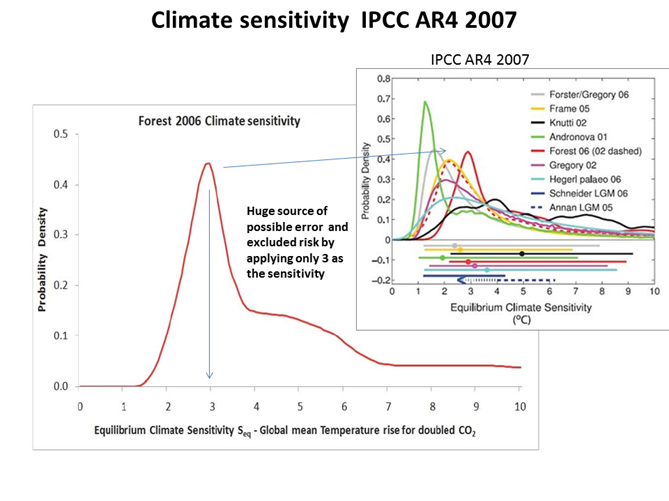
The climate sensitivity is defined as the global average temperature increase for a doubling of atmospheric CO2 concentration.
Since the first assessment in 1990 a single metric of 3 is taken as the sensitivity, but says a sensitivity above its upper range of 4.5 is possible. The climate sensitivity upper range from the models goes up as high as over 10(C), which the scientists say means the upper range is poorly constrained. The lower limit is definite and well constrained. Of course this is the opposite of what we need.
The IPCC image above of one of the 2006 most recent papers (Forest 2006) shows a large probability and so risk that the sensitivity will be 6, or double what is applied for projections of impacts.
Since the IPCC AR4 there have been two strong papers based on observations as well as modeling that find the sensitivity is the top end of the IPCC range.
As James Hansen has explained, the sensitivity however is dynamic not static, because of carbon feedbacks that increase with warming. The single metric of 3 does not allow for added carbon GHG emissions (CO2 and methane) which is carbon feedback. It also does not allow for non linear or abrupt warming, though we know from the ice cores that has happened quite often in the past.
If in the real world warming, the sensitivity turns out to be the top of the IPCC range at 4.5 (not 3) all the projections are going to be in error by 50%. We must call for an emergency response now.
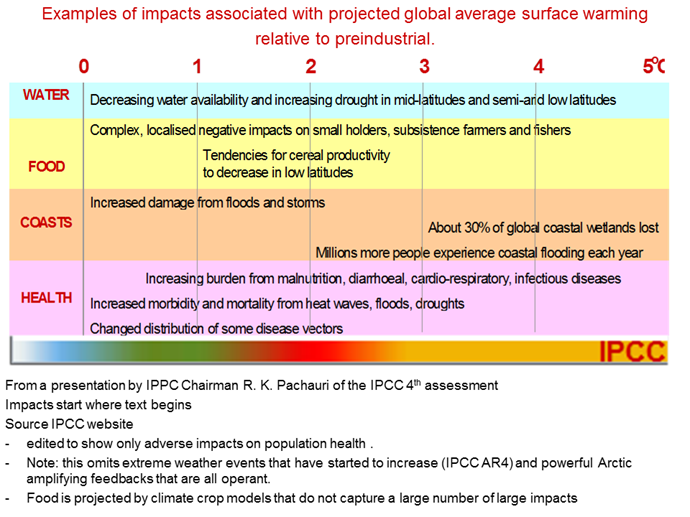

The 2016 Planetary Health Alliance (2019 VIDEO)
Video Dr. H. Montgomery's 2018 lecture says it all
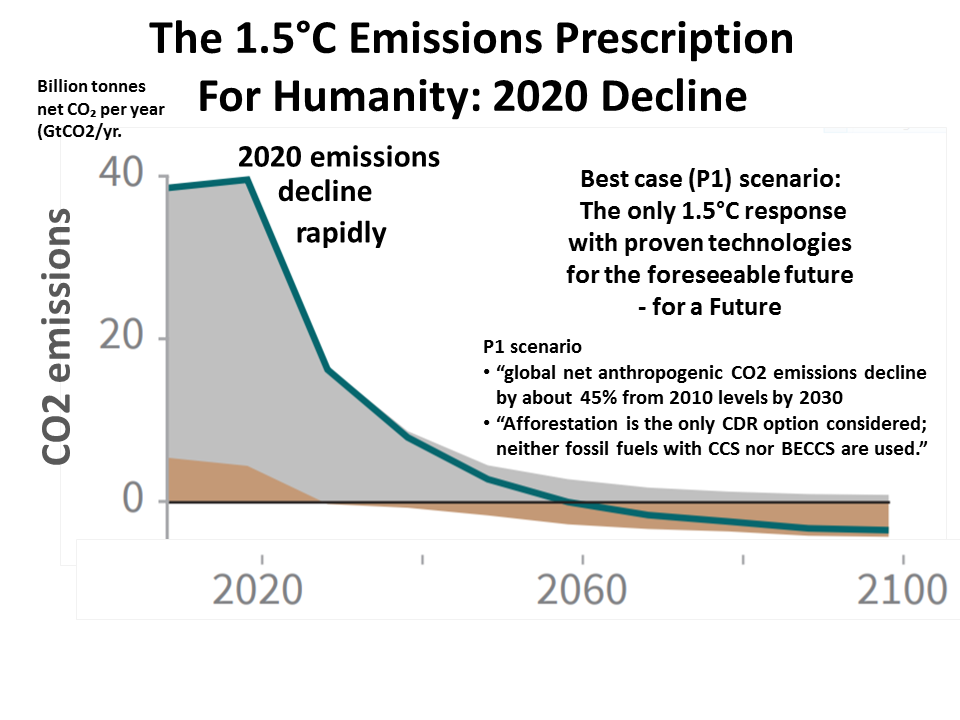
Lancet Countdown (Nov)2018 Report for policy makers
2017 WHO 5th Climate & Health Summit
2014 Lancet From Public to Planetary Health:
A Manifesto
2014 BMJ Climate Change & Human Survival
2014 BMJ Climate Change
is a Health Emergency
IPCC 5th Assessment
Climate & Health Council




